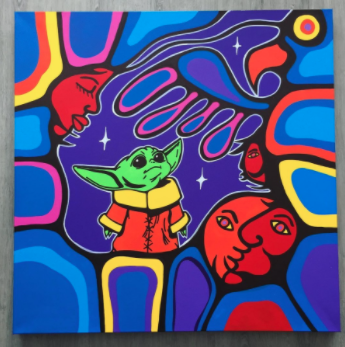Post #12
Recently, for our Indigenous Film and New Media Art class, students were asked to conduct a presentation on an Indigenous film or new media artist. I chose to conduct my presentation on Blake Angeconeb. Blake is not a film or new media artist in that his art is produced by a digital medium, but rather by the medium of acrylic paint on canvass. However, his work incorporates many new media elements. First, Blake shares his work on Instagram (@blakeangeconeb), which is a social (new) media platform. Whether this makes someone a new media artist or not, I am not sure. I am not sure what determines what kind of artist someone is, the medium used to create art, or the space used to share art. Or, a combination of both? Second, Blake’s work often displays new media images and symbols, often those seen in Western media and popular culture, for example, Baby Yoda, Mario, Winnie-the-Pooh, and many more characters. Even social media memes that reach millions of people virtually will make an appearance in his art, for example, the sitting Bernie Sanders meme and the Cranberry juice Tik-Tok man. Through the amalgamation of traditional Indigenous art and modern popular culture, and through the utilization of new media platforms, Blake achieves a balance of old and new media in his art.
I asked Blake if his artwork intends to make statements about colonization, reconciliation, sovereignty, or other socio-political-cultural themes. He said he would have to get back to me on that one. Therefore, my armature eye attempted to interpret his art for these themes. What I saw in Blake’s art was two strikingly different cultures, Indigenous and Western popular culture. Blake brings together elements of both cultures. In this amalgamation they become complimentary. This makes me think of reconciliation. I then thought of colonization. I saw Indigenous symbols and patterns displayed as the background. I thought of Indigenous groups being the true and longest stewards of turtle island, setting the foundation, the background, of this continent. The popular culture elements are smaller and centered. Similar to Western colonizers, who settled recently, placing themselves in the center of this foundation.
What I enjoyed most about researching Blake was hearing of the artists who inspired him; some of which are digital artists, such as Mad Dog Jones; street artists, such as David Choe and Banksy; Indigenous artists such as Norval Morrisseau’s and Carl ray; and another Winnipeg artist, Cash Akoza. Through exploring these artists, I was able to see how this inspiration manifested in some of Blake’s artwork (Bansky’s black and white characters, Morrisseau’s colourful patterns and cultural symbols). Seeing these similarities felt like peering into the mind of the creative. As a result of this interview, my awareness of current artists has significantly expanded and has triggered a deeper interest in me to continue exploring artists.
I am grateful that Blake took the time to answer some of my questions.
—
Karla Sewell
Artwork by Blake Angeconeb, posted on his Instagram profile @blakeangeconeb, captioned “The finale of the Baby Yoda series with the biggest one yet at 36”x36”. Miigwetch @wabber for letting me create this.”
Artwork by Blake Angeconeb, posted on his Instagram profile @blakeangeconeb, captioned “The deadliest dude on the internet rn *laughing emoji*”


